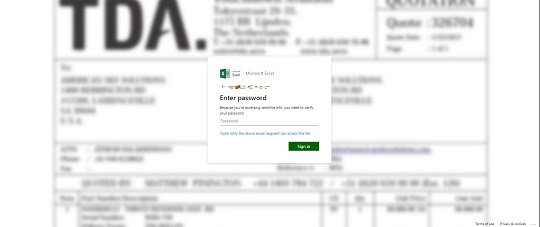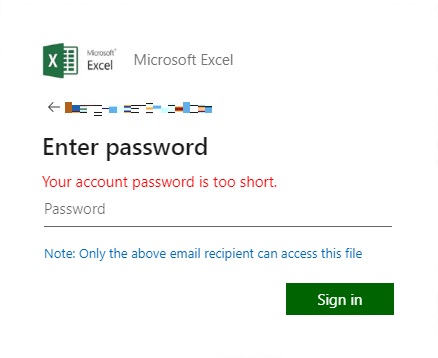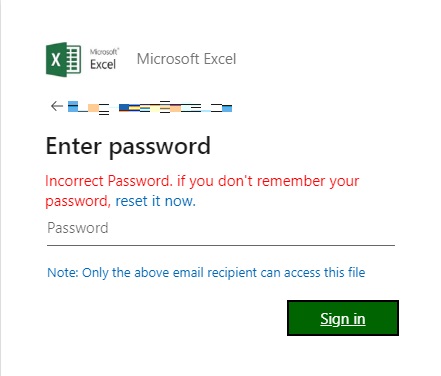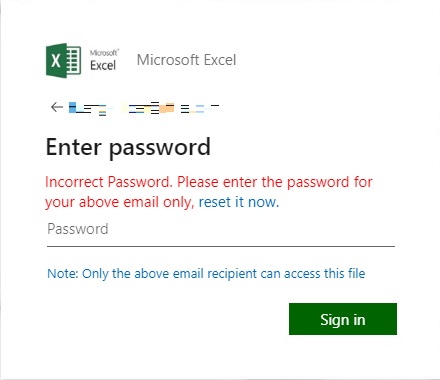Trojan.HTML.PHISH.QURAAOOIUE
Trojan:HTML/Phish!MSR (MICROSOFT)
Windows

Tipo de malware
Trojan
Destructivo?
No
Cifrado

In the Wild:
Sí
Resumen y descripción
It arrives on a system as a file dropped by other malware or as a file downloaded unknowingly by users when visiting malicious sites.
Este malware no tiene ninguna rutina de propagación.
Este malware no tiene ninguna rutina de puerta trasera.
Detalles técnicos
Detalles de entrada
It arrives on a system as a file dropped by other malware or as a file downloaded unknowingly by users when visiting malicious sites.
Propagación
Este malware no tiene ninguna rutina de propagación.
Rutina de puerta trasera
Este malware no tiene ninguna rutina de puerta trasera.
Información sustraída
Este malware envía la información recopilada a la siguiente URL a través de HTTP POST:
- https://{BLOCKED}nova.com.ge/boss/lambo.php
Otros detalles
Hace lo siguiente:
- It disguises itself as a login page to access a document:

- It disables the following keyboard shortcuts and mouse actions when interacting with the fake login page:
- CTRL+C - used to copy text or items from the webpage
- CTRL+V - used to paste text or items on the webpage
- CTRL+A - used to select all text or items on the webpage
- CTRL+F - used to search text on the webpage
- CTRL+H - used to open the browsing history
- CTRL+E - used to access the address bar
- CTRL+S - used to save the webpage
- CTRL+U - used to view the page source
- F12 - used to view the page source
- CTRL+F6 - used to skip to contents
- CTRL+SHIFT+I - used to open the Developer Tools
- CTRL+SHIFT+J - used to open the console tab in Developer Tools
- Browser's Context Menu - usually done by clicking the right mouse button
- If the input password has less than 5 characters, it displays the following message:

- If the input password has more than 5 characters and submitted for the first time, it sends the email and input password to the C&C Server. Then, it displays the following message to bait the victim to carefully input the correct password again:

- If the input password has exactly 5 characters and submitted for the first time, or if the password has 5 or more characters and submitted the second time, it sends the email and input password to the C&C Server. Then, it displays the following message:

- If the input password has 5 or more characters and submitted for the third time, it sends the email and input password to the C&C Server and loads the following webpage:

- It initially connects to the following URL to load the fake login page:
- https://{BLOCKED}ess-zebrax0x.surge.sh/excelUILOGO.js
- It redirects the webpage to the following URL to load the error page:
- https://{BLOCKED}k.office365.com/Encryption/ErrorPage.aspx?src=3&code=11&be=SN6PR04MB4014&fe=JNAP275CA0040.ZAFP275.PROD.OUTLOOgK.COM&loc=en-US&itemID=E4E_M_e9df154a-e4b8-4486-8aec-7acceeb93fee
- It connects to the following URLs to display images inside the webpage:
- https:/{BLOCKED}o.com/9c58a897ff8731c750bc9ec6fefffc26.png
- https://{BLOCKED}o.com/78c24d6313b46234ef3d411883c0aa32.png
- https://{BLOCKED}.msftauth.net/shared/1.0/content/images/favicon_a_eupayfgghqiai7k9sol6lg2.ico
- https://{BLOCKED}.msftauth.net/shared/1.0/content/images/arrow_left_7cc096da6aa2dba3f81fcc1c8262157c.png
- https://{BLOCKED}.msftauth.net/shared/1.0/content/images/arrow_left_a9cc2824ef3517b6c4160dcf8ff7d410.svg
- https://{BLOCKED}.msftauth.net/shared/1.0/content/images/microsoft_logo_ed9c9eb0dce17d752bedea6b5acda6d9.png
- https://{BLOCKED}.msftauth.net/shared/1.0/content/images/microsoft_logo_ee5c8d9fb6248c938fd0dc19370e90bd.svg
Soluciones
Step 1
Los usuarios de Windows ME y XP, antes de llevar a cabo cualquier exploración, deben comprobar que tienen desactivada la opción Restaurar sistema para permitir la exploración completa del equipo.
Step 2
Explorar el equipo con su producto de Trend Micro para eliminar los archivos detectados como Trojan.HTML.PHISH.QURAAOOIUE En caso de que el producto de Trend Micro ya haya limpiado, eliminado o puesto en cuarentena los archivos detectados, no serán necesarios más pasos. Puede optar simplemente por eliminar los archivos en cuarentena. Consulte esta página de Base de conocimientos para obtener más información.
Rellene nuestra encuesta!


